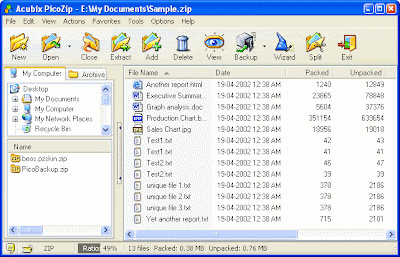Disk Caching
-A mechanism for improving the time it takes to read from or write to a hard disk.
-Today, the disk cache is usually included as part of the hard disk.
-A disk cache can also be a specified portion of random access memory (RAM).
-The disk cache holds data that has recently been read and, in some cases, adjacent data areas that are likely to be accessed next.
File Compression
-File compression software can accept one or more related files, combine them and reduce their size to make them more suitable for storage or transmission.
-Archiving is the term generally used when compressing files for storage, but the idea is the same as for file transfer.
-File compression eliminates data redundancy, using an algorithm that locates repeating patterns of the binary numbers zero (0) and one (1).
-The more repeating patterns compression software can find and eliminate, the greater the compression.
File Decompression
-Data decompression is the reverse--the decoding of compressed data to restore the original data.
-Compression/decompression algorithms look for redundancies in data, then minimize them using predetermined algorithms (methods). There are different algorithms used to achieve different compression rates.
-Solid files are called "archives." They can hold more than one file. There is a tradeoff between higher density rates and compression/decompression time.
-Archive files can be manipulated with utilities such as WinZip or IZArc.
Internet Hard Drive
-The sole purpose of an Internet hard drive is to offer a means of accessing your computer files (pictures, documents, music, videos, etc.) from any computer, as long as that computer has access to the Internet.
-An Internet hard drive will allow you to "deposit" your computer files into a remote hard drive, and then later access those very same files from any other computer.
Solid-State Storage
- A data storage device that uses solid-state memory to store persistent data with the intention of providing access in the same manner of a traditional block i/o hard disk drive.
- SSDs are distinguished from traditional hard disk drives, which are electromechanical devices containing spinning disks and movable read/write heads.
- SSDs are typically less susceptible to physical shock, are silent, and have lower access time and latency, but are more expensive per gigabyte (GB) and typically support a limited number of writes over the life of the device.
- SSDs use the same interface as hard disk drives, thus easily replacing them in most applications.
-A mechanism for improving the time it takes to read from or write to a hard disk.
-Today, the disk cache is usually included as part of the hard disk.
-A disk cache can also be a specified portion of random access memory (RAM).
-The disk cache holds data that has recently been read and, in some cases, adjacent data areas that are likely to be accessed next.
File Compression
-File compression software can accept one or more related files, combine them and reduce their size to make them more suitable for storage or transmission.
-Archiving is the term generally used when compressing files for storage, but the idea is the same as for file transfer.
-File compression eliminates data redundancy, using an algorithm that locates repeating patterns of the binary numbers zero (0) and one (1).
-The more repeating patterns compression software can find and eliminate, the greater the compression.
File Decompression
-Data decompression is the reverse--the decoding of compressed data to restore the original data.
-Compression/decompression algorithms look for redundancies in data, then minimize them using predetermined algorithms (methods). There are different algorithms used to achieve different compression rates.
-Solid files are called "archives." They can hold more than one file. There is a tradeoff between higher density rates and compression/decompression time.
-Archive files can be manipulated with utilities such as WinZip or IZArc.
Internet Hard Drive
-The sole purpose of an Internet hard drive is to offer a means of accessing your computer files (pictures, documents, music, videos, etc.) from any computer, as long as that computer has access to the Internet.
-An Internet hard drive will allow you to "deposit" your computer files into a remote hard drive, and then later access those very same files from any other computer.
Solid-State Storage
- A data storage device that uses solid-state memory to store persistent data with the intention of providing access in the same manner of a traditional block i/o hard disk drive.
- SSDs are distinguished from traditional hard disk drives, which are electromechanical devices containing spinning disks and movable read/write heads.
- SSDs are typically less susceptible to physical shock, are silent, and have lower access time and latency, but are more expensive per gigabyte (GB) and typically support a limited number of writes over the life of the device.
- SSDs use the same interface as hard disk drives, thus easily replacing them in most applications.







No comments:
Post a Comment